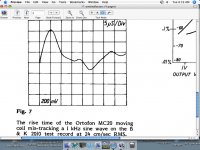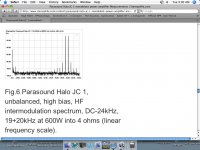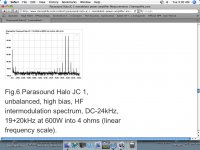And I just ask that many here read the material offered, before asking me questions about the subject. Is it too much to ask? '-)
At least I did 30yr. ago and I am on the side that thinks the conclusions are in part wrong. I have produced a counter example, PMA measured it and Ron Quan (I saw Ron two weeks ago and we avoided audio talk) also confirmed the performance. Undegenerated bi-polar with open loop BW of a few Hz and gobs of feedback. Gain bandwidth product does the trick, keeps the input error signal small all according to prevailing theory.
PMA, you are right. There is some 7th harmonic present at -120dB. It should go down at lower output levels. I suspect that the JC-1 power amp following it will be clipping at this point. Let me check. Yes, I checked: The output to the speaker would be 800W into a 4 ohm load. I suspect that even the JC-1 would dominate the distortion spectrum.
Last edited:
Gasp! Horror! You don't mean that the naive theory I read in the textbooks is actually true?scott wurcer said:Gain bandwidth product does the trick, keeps the input error signal small all according to prevailing theory.
While one can safely recommend the AD797 for many applications, I found another op amp that sounds just as good at 1/2 the price. It is the LME49990.
That is what I use in my JC-3 front end to amplify the first 30dB. Therefore it HAS to accurately pass the mistracking artifacts of the Ortofon cartridge which is a large pulse with a 5us r.t.
That is what I use in my JC-3 front end to amplify the first 30dB. Therefore it HAS to accurately pass the mistracking artifacts of the Ortofon cartridge which is a large pulse with a 5us r.t.
Attachments
What is quite interesting is the fact, that the AD797, with no extraordinary slew rate 20V/us, performs in a 19 + 20 kHz test much better than many (or most of) devices with slew rate > 50V/us.
Not really; the large signal slew rate (usually specified in data sheets) has little to no relationship with the small signal slew rate (defined by the gain-bandwidth product), which is involved in the small signal 19+20KHz test results.
I've tried my 1/3 octave noise test at two speeds too, the stylus can't track the recording even when it stays in the groove. So remind me why this thread has circled again back 35 yr. to talk about why 741's are not good for audio.
Those who cannot remember the past.....
Let's go back a bit. The first digital IC's were destined for digital computers. An interesting break through was the first use to make frequency counters. Now since that was before LEDs, Nixie tubes were often used as the readout, although the first hobby version used 10 light bulbs. Later a 7 segment incandescent display was introduced.
Now frequency counters had existed before digital ICs, but that is when they became quite common.
The next offshoot was to make these counters into digital voltmeters. The attempts to use a voltage controlled oscillator had the obvious problem of zero volts require a zero hertz output. Also they suffered from a lack of linearity. The popular circuit at first was the single slope A/D converter. This was as simple as comparing the input voltage to that on a capacitor. The capacitor was discharged and then a constant current was applied while the digital counter clocked up until the voltage on the capacitor was the same as the input voltage.
The issues in the design were not just the accuracy of the capacitor and current source, but also the trigger points of the comparator. This resulted in the dual slope converter. The capacitor was charged to match the input voltage and the timing was done while the capacitor was discharged. Thus reducing possible drift and errors.
This placed more stringent requirements on the current source, but those could be designed around.
Now an outgrowth of this was the ability to produce triangle waves. (A current source charging and discharging a capacitor.) These days there are better digital techniques so although the triangle wave remains as an output on function generators, it is not used much.
But back then the accuracy of triangle waves was important. One issue was that high frequency triangle waves had rolled off tops. That brought up the issue of slew rate. A number of papers and AP notes explained how this limited certain designs. This is where large and small signal slew rate got named.
Now the introduction of distortion caused by slew rate limits inside audio power amplifiers added one more important factor, gain (or transconductance,) If your audio amplifier only had a gain of 2 you would need much less slew rate than if it were 200. (Duh!) So it became possible to have amplifiers with the same gain-bandwidth but quite different gain-slew rate limits.
Now the 741 is an obsolete design because the production processes are not as limited as they were when it was introduced. As mention by Scott it would probably cost way more to actually make such a device today than any of the more modern (and better) successors.
But the issues of what causes different types of distortion don't go away because in most cases the products are better. We just see fewer issues. When you forget why you were looking at the problem, when it reappears in perhaps a smaller or slightly different form, then you have not remembered the past.
Gpagag, OF COURSE, we worry about costs for a 'cost effective' high quality phono stage like the JC-3. We WOULD have used the AD797, if we had not found a similar, lower priced IC to replace it. I don't like to pay extra either, if I can get the same performance with something less expensive.
Jack Bybee is an old man. At 84 years old, he is NOT into 'mass production' of whatever he makes. He just does the best that he can, at a few different price points. He certainly works harder than I do, but he seems to need the activity. I can sit around arguing with people here, '-), but Jack needs to get out of the house, itself. This is a great excuse to do so, AND he has a bunch of hi end customers who invite him to their house (or country) to listen with them.
I have not seen as much practical design info in later articles in the AES, compared to past decades.
Perhaps because this aspect of audio (getting an electrical signal from point A to point B and making it bigger or smaller) is a solved problem and there's little or no truly new research to do in that area?
Sorry that my references are beneath you, SY. I thought I was really helping would be designers with knowledge developed over 35 years ago. It doesn't have to be 're-invented' here.
John, I think you should give Matti (and yourself) some credit for opening the minds of audio designers 35 yrs ago to these TIM and slew rate issues. Since then, most savvy designers (and lots of them here) know how to avoid them; it's not that you tell them anything new.
Granted, there are still designers or amateurs that think feedback causes slew rate limiting or TIM, but hey you can't educate everyone.
jan
I have not seen as much practical design info in later articles in the AES, compared to past decades. That is why I have put some 'old' stuff up, for those of you who might have been children when it was first introduced.
A lot of it is now issued by committees as advisory papers. Of course it is on topics of current interest such as digital transport of audio signals.
Too often tutorials seem to be confused with being new information.
I had a recent conversation about advances in audio. My point was not the difficulty in keeping up with what is new, rather it is getting a better understanding of what is basic.
You know stuff like why double blind testing is not very useful.
As if I knew
Thanks for giving me the time to enjoy the beer
Granted, there are still designers or amateurs that think feedback causes slew rate limiting or TIM, but hey you can't educate everyone.
jan
Feedback IS a necessary factor to give normal slew rate limiting. The op amp is a perfect example of worst case slew rate limiting, in principle.
Teaching is a hard job.
But being a student, is a mind bogging situation.
Second bottle
George
Feedback IS a necessary factor to give normal slew rate limiting. The op amp is a perfect example of worst case slew rate limiting, in principle.
You must be kidding! Slew rate limiting is caused by insufficient charging current for a capacitor in the amp (often the compensation cap).
It can occur also in open loop amps, if you feed them high-level, fast signals faster than the designed-in slewrate.
It is true that is you have a marginal design, adding feedback can worsen the occurence of slew rate limiting because it increases the error signal at the input, but it doesn't cause SRL.
Fear for slew rate limiting is no reason to shy away from feedeback - you just have to get yourself a competent design.
jan
- Status
- Not open for further replies.
- Home
- Member Areas
- The Lounge
- John Curl's Blowtorch preamplifier part II


